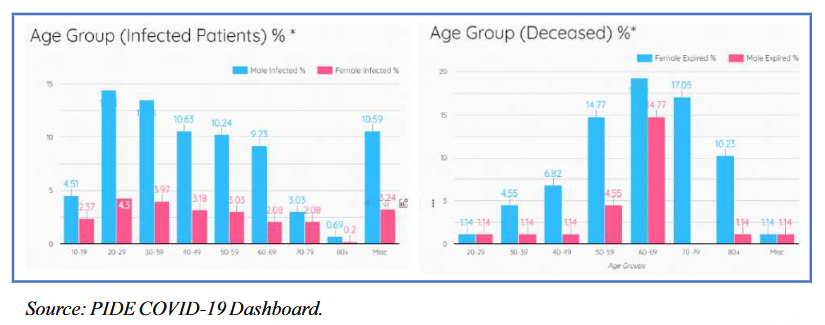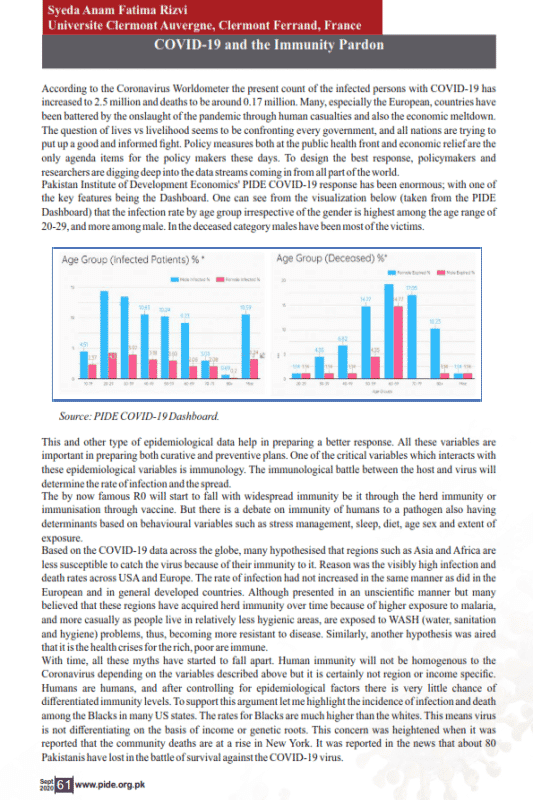
Pakistan Institute of Development Economics
- Home
Our Portals
MenuMenuMenuMenuMenuMenuMenu - ResearchMenuMenuMenuMenuMenuMenuMenu
- Discourse
- The PDR
- Our Researchers
- Academics
- Degree Verification
- Thesis Portal
- Our Portals
COVID-19 and the Immunity Pardon (P & R Vol.1 Issue 1)
According to the Coronavirus Worldometer the present count of the infected persons with COVID-19 has increased to 2.5 million and deaths to be around 0.17 million. Many, especially the European, countries have been battered by the onslaught of the pandemic through human casualties and also the economic meltdown. The question of lives vs livelihood seems to be confronting every government, and all nations are trying to put up a good and informed fight. Policy measures both at the public health front and economic relief are the only agenda items for the policy makers these days. To design the best response, policymakers and researchers are digging deep into the data streams coming in from all part of the world. Pakistan Institute of Development Economics’ PIDE COVID-19 response has been enormous; with one of the key features being the Dashboard. One can see from the visualization below (taken from the PIDE Dashboard) that the infection rate by age group irrespective of the gender is highest among the age range of 20-29, and more among male. In the deceased category males have been most of the victims.
 This and other type of epidemiological data help in preparing a better response. All these variables are important in preparing both curative and preventive plans. One of the critical variables which interacts with these epidemiological variables is immunology. The immunological battle between the host and virus will determine the rate of infection and the spread.
This and other type of epidemiological data help in preparing a better response. All these variables are important in preparing both curative and preventive plans. One of the critical variables which interacts with these epidemiological variables is immunology. The immunological battle between the host and virus will determine the rate of infection and the spread.
The by now famous R0 will start to fall with widespread immunity be it through the herd immunity or immunisation through vaccine. But there is a debate on immunity of humans to a pathogen also having determinants based on behavioural variables such as stress management, sleep, diet, age sex and extent of exposure. Based on the COVID-19 data across the globe, many hypothesised that regions such as Asia and Africa are less susceptible to catch the virus because of their immunity to it. Reason was the visibly high infection and death rates across USA and Europe.
The rate of infection had not increased in the same manner as did in the European and in general developed countries. Although presented in an unscientific manner but many believed that these regions have acquired herd immunity over time because of higher exposure to malaria, and more casually as people live in relatively less hygienic areas, are exposed to WASH (water, sanitation and hygiene) problems, thus, becoming more resistant to disease. Similarly, another hypothesis was aired that it is the health crises for the rich, poor are immune. With time, all these myths have started to fall apart. Human immunity will not be homogenous to the Coronavirus depending on the variables described above but it is certainly not region or income specific.
Humans are humans, and after controlling for epidemiological factors there is very little chance of differentiated immunity levels. To support this argument let me highlight the incidence of infection and death among the Blacks in many US states. The rates for Blacks are much higher than the whites. This means virus is not differentiating on the basis of income or genetic roots. This concern was heightened when it was reported that the community deaths are at a rise in New York. It was reported in the news that about 80 Pakistanis have lost in the battle of survival against the COVID-19 virus.
In a recent move to protect the lives through livelihood protection, the government of Pakistan has decided to ease some restrictions of lockdown albeit with SOPs for social distancing and increasing the awareness campaign. So far, the hotspots for the pandemic have not been linked to slums, or urban congestion or income poverty in general. But as we move closer to the critical time of mass infections one has to plan accordingly.
This plan should not be based on the false paradigm of herd immunity with reference to these characteristics as doing so could be disastrous. Determinants of immunity would be variables which are consistent across the globe and not linked with a region or a race. Learning from other countries would still be the best course to design our domestic policy. As they say, common sense should prevail and here the common sense is that there is no immunity pardon. A human is a human be they European or African or Pakistani!



